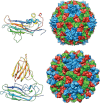Confessions of an icosahedral virus crystallographer
- PMID: 23291268
- PMCID: PMC3624677
- DOI: 10.1093/jmicro/dfs097
Confessions of an icosahedral virus crystallographer
Abstract
This is a personal history of my structural studies of icosahedral viruses that evolved from crystallographic studies, to hybrid methods with electron cryo-microscopy and image reconstruction (cryoEM) and then developed further by incorporating a variety of physical methods to augment the high resolution crystallographic studies. It is not meant to be comprehensive, even for my own work, but hopefully provides some perspective on the growth of our understanding of these remarkable biologic assemblies. The goal is to provide a historical perspective for those new to the field and to emphasize the limitations of any one method, even those that provide atomic resolution information about viruses.
Figures





Similar articles
-
Single particle cryo-electron microscopy and 3-D reconstruction of viruses.Methods Mol Biol. 2014;1117:401-43. doi: 10.1007/978-1-62703-776-1_19. Methods Mol Biol. 2014. PMID: 24357374 Free PMC article.
-
Observation of Bacteriophage Ultrastructure by Cryo-electron Microscopy.Methods Mol Biol. 2018;1693:43-55. doi: 10.1007/978-1-4939-7395-8_5. Methods Mol Biol. 2018. PMID: 29119431
-
Three-dimensional asymmetric reconstruction of tailed bacteriophage.Methods Enzymol. 2010;482:185-210. doi: 10.1016/S0076-6879(10)82008-7. Methods Enzymol. 2010. PMID: 20888962 Free PMC article.
-
Adding the third dimension to virus life cycles: three-dimensional reconstruction of icosahedral viruses from cryo-electron micrographs.Microbiol Mol Biol Rev. 1999 Dec;63(4):862-922, table of contents. doi: 10.1128/MMBR.63.4.862-922.1999. Microbiol Mol Biol Rev. 1999. PMID: 10585969 Free PMC article. Review.
-
Tools for Model Building and Optimization into Near-Atomic Resolution Electron Cryo-Microscopy Density Maps.Methods Enzymol. 2016;579:255-76. doi: 10.1016/bs.mie.2016.06.003. Epub 2016 Aug 12. Methods Enzymol. 2016. PMID: 27572730 Free PMC article. Review.
Cited by
-
Atomic cryo-EM structures of viruses.Curr Opin Struct Biol. 2017 Oct;46:122-129. doi: 10.1016/j.sbi.2017.07.002. Epub 2017 Aug 5. Curr Opin Struct Biol. 2017. PMID: 28787658 Free PMC article. Review.
-
Icosahedral virus structures and the protein data bank.J Biol Chem. 2021 Jan-Jun;296:100554. doi: 10.1016/j.jbc.2021.100554. Epub 2021 Mar 17. J Biol Chem. 2021. PMID: 33744290 Free PMC article. Review.
-
Breaking Symmetry in Viral Icosahedral Capsids as Seen through the Lenses of X-ray Crystallography and Cryo-Electron Microscopy.Viruses. 2018 Feb 7;10(2):67. doi: 10.3390/v10020067. Viruses. 2018. PMID: 29414851 Free PMC article. Review.
-
Towards an integrative structural biology approach: combining Cryo-TEM, X-ray crystallography, and NMR.J Struct Funct Genomics. 2014 Sep;15(3):117-24. doi: 10.1007/s10969-014-9179-9. Epub 2014 Apr 20. J Struct Funct Genomics. 2014. PMID: 24748171 Free PMC article.
-
A cool hybrid approach to the herpesvirus 'life' cycle.Curr Opin Virol. 2014 Apr;5(100):42-9. doi: 10.1016/j.coviro.2014.01.008. Epub 2014 Feb 16. Curr Opin Virol. 2014. PMID: 24553093 Free PMC article. Review.
References
-
- Harrison S C. A point-focusing camera for single-crystal diffraction. J. Appl. Cryst. 1968;1:84–90. doi:10.1107/S0021889868005054. - DOI
-
- Harrison S C. Structure of tomato bushy stunt virus. I. The spherically averaged electron density. J. Mol. Biol. 1969;42:457–483. doi:10.1016/0022-2836(69)90236-8. - DOI - PubMed
-
- Harrison S C. Structure of tomato bushy stunt virus at 25 Å resolution. Cold Spring Harb. Symp. Quant. Biol. 1971;36:495–501. doi:10.1101/SQB.1972.036.01.063. - DOI - PubMed
-
- Harrison S C, Jack A. Structure of tomato bushy stunt virus. Three-dimensional x-ray diffraction analysis at 16 A resolution. J. Mol. Biol. 1975;97:173–191. doi:10.1016/S0022-2836(75)80033-7. - DOI - PubMed
-
- Jack A, Harrison S C, Crowther R A. Structure of tomato bushy stunt virus. II. Comparison of results obtained by electron microscopy and x-ray diffraction. J. Mol. Biol. 1975;97:163–172. doi:10.1016/S0022-2836(75)80032-5. - DOI - PubMed
Publication types
MeSH terms
Grants and funding
LinkOut - more resources
Full Text Sources
Other Literature Sources

